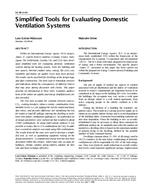Heat transfer coefficient and pressure-drop data were taken during in-tube condensation of refrigerant mixtures in a smooth copper tube with an outer diameter (O.D.) of three/eighths in. The data were taken at temperatures of 30 deg C and 40 deg C. Five nonazeotropic refrigerant mixtures and pure R125 were tested and compared against baseline data for R22. Four different mass fluxes ranging from 125 to 375 kg/s.m2 were tested. The mixtures tested, on a mass basis, were R125 (40%)/R32 (60%), R134a (90%)/R32 (10%), R134a (75%)/R32 (25%), R32 (30%)/R134a (60%), and R125 (44%)/R143a (53%)/R134a (4%). When compared on an equal mass flux basis, only the R125 (40%)/R32 (60)% mixture had a heat transfer coefficient higher than that of R22. All the refrigerants tested had lower heat transfer coefficients than R22 when compared on an equal heating capacity basis. The equal heating capacity is computed by multiplying the mass flux by the corresponding refrigerant’s enthalpy of vaporisation. This makes it easier to compare refrigerants with greatly different enthalpies of vaporisation. Also, the heat transfer coefficients of all the refrigerants decreased with increasing temperature.
KEYWORDS: condensation, heat transfer coefficient, heat flow, refrigerants, mixtures, R125, R22, R32, R134a, R143a, testing, pressure drop, tubes, copper, temperature, non azeotropic, comparing, heat content, vaporising
Citation: Symposium, ASHRAE Trans. 1994, Vol.100, Part 2
Product Details
- Published:
- 1994
- File Size:
- 1 file , 1.3 MB
- Product Code(s):
- D-17481


